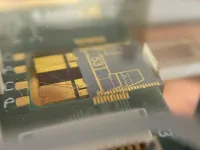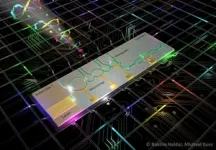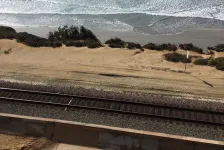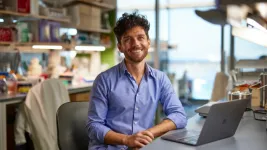Quantum light source goes fully on-chip, bringing scalability to the quantum cloud
The new development is scalable and suitable for use in photonic quantum computers
2023-04-17
(Press-News.org)
An international team of researchers from Leibniz University Hannover (Germany), the University of Twente (Netherlands), and the start-up company QuiX Quantum has presented an entangled quantum light source fully integrated for the first time on a chip. “Our breakthrough allowed us to shrink the source size by a factor of more than 1000, allowing reproducibility, stability over a longer time, scaling, and potentially mass-production. All these characteristics are required for real-world applications such as quantum processors,” says Prof. Dr. Michael Kues, head of the Institute of Photonics, and board member of the Cluster of Excellence PhoenixD at Leibniz University Hannover.
Quantum bits (qubits) are the basic building blocks of quantum computers and the quantum internet. Quantum light sources generate light quanta (photons) that can be used as quantum bits. On-chip photonics has become a leading platform for processing optical quantum states as it is compact, robust, and allows to accommodate and arrange many elements on a single chip. Here, light is directed on the chip through extremely compact structures, which are used to build photonic quantum computing systems. These are already accessible today through the cloud. Scalably implemented, they could solve tasks that are inaccessible to conventional computers due to their limited computing capacities. This superiority is referred to as quantum advantage.
"Until now, quantum light sources required external, off-chip and bulky laser systems, which limited their use in the field. However, we overcome these challenges through a novel chip design and by exploiting different integrated platforms," says Hatam Mahmudlu, a Ph.D. student in Kues' team. Their new development, an electrically-excited, laser-integrated photonic quantum light source, fits entirely on a chip and can emit frequency-entangled qubit states.
“Qubits are very susceptible to noise. The chip must be driven by the laser field, completely free from noise, requiring an on-chip filter. Previously, it was a major challenge to integrate laser, filter, and a cavity on the same chip as there was no unique material that was efficient to build these different components,” says Dr. Raktim Haldar, a Humboldt fellow in Kues’ group. The key was the ‘hybrid technology’ that sticks the laser made of indium phosphide, a filter, and a cavity made of silicon nitride and brings them together into a single chip. On the chip, in a spontaneous nonlinear process, two photons are created from a laser field. Each photon spans a range of colours simultaneously, which is called ‘superposition’, and the colours of both photons are correlated, i.e., the photons are entangled and can store quantum information. "We achieve remarkable efficiencies and state qualities required for application in quantum computers or the quantum internet," says Kues.
"Now we can integrate the laser with other components on a chip so that the whole quantum source is smaller than a one-euro coin. Our tiny device could be considered a step towards quantum advantage on a chip with photons. Unlike Google, which currently uses super-cold qubits in cryogenic systems, the quantum advantage could be achieved with such photonic systems on a chip even at room temperature," says Haldar. The scientists also expect their discovery to help lower the production costs of applications. "We can imagine that our quantum light source will soon be a fundamental component of programmable photonic quantum processors," says Kues. The results of the study were published in the journal Nature Photonics.
Prof. Dr. Michael Kues is head of the Institute of Photonics and a board member of the Cluster of Excellence PhoenixD: Photonics, Optics, and Engineering - Innovation across Disciplines at Leibniz University Hannover, Germany. The PhoenixD research cluster comprises around 120 scientists working on novel integrated optics. The German Research Foundation (DFG) funds PhoenixD with about 52 million euros from 2019 to 2025. Dr. Raktim Haldar is an Alexander von Humboldt Research Fellow at the Institute of Photonics, and Hatam Mahmudlu is a doctoral student in Kues' team. The research was funded by the Federal Ministry of Education and Research (BMBF) and the European Research Council (ERC).
END
ELSE PRESS RELEASES FROM THIS DATE:
2023-04-17
Researchers from Tokyo Medical and Dental University (TMDU) find that, when a stroke therapy is linked to a specific kind of lipid and injected into the blood, it is taken up preferentially in the stroke-lesioned brain
Tokyo, Japan – To get therapies into the brain after a stroke, researchers are increasingly making use of the blood–brain barrier, which allows only certain molecules to pass from the blood into the brain. In a study published earlier this year in Molecular Therapy, ...
2023-04-17
BEER-SHEVA, Israel, April 17, 2023 – Scientific research must meet clear ethical guidelines to prevent harm to participants. However, research can also indirectly harm individuals and social groups, for example by shaping social perceptions and inspiring policy. Researchers receive little to no training on how to consider and minimize such harm.
To that end, Ben-Gurion University of the Negev's Dr. Niv Reggev and his international colleagues have published ten simple rules for socially responsible science. The ...
2023-04-17
In parts of California’s iconic mountainous coasts, breathtaking beauty is punctuated by brusque signs warning spectators to stay back from unstable cliffs. The dangers of coastal erosion are an all-too-familiar reality for the modern residents of these communities. Now, with a new tool, researchers are bringing historical perspective to the hotly debated topic of how to manage these disappearing coastlines.
Using a model that incorporates measurements of the amount of time coastal cliffs and their remnant deposits were exposed at the Earth’s surface, Stanford researchers found that the rate of cliff erosion in the past 100 years is ...
2023-04-17
People living with long Covid who suffer from loss of smell show different patterns of activity in certain regions of the brain, a new study led by UCL researchers has found.
The research used MRI scanning to compare the brain activity of people with long Covid who lost their sense of smell, those whose smell had returned to normal after Covid infection, and people who had never tested positive for Covid-19.
Published in eClinicalMedicine, the observational study found that the people with long Covid smell loss had reduced brain activity and impaired communication between two parts of the brain which process ...
2023-04-17
SAN ANTONIO — April 17, 2023 —Southwest Research Institute staff members have converged upon Detroit this week to share their respective expertise with the mobility industry at the 2023 SAE International WCX™ World Congress Experience.
WCX is the “largest technical mobility event developed by the industry, for the industry,” according to SAE. The conference, which takes place April 17-20, invites mechanical, electrical and software engineers working in mobility from around the world to share knowledge and research to overcome the latest challenges facing the industry.
As leaders in mobility and automotive research, ...
2023-04-17
Through careful crossbreeding and selection, University of Maryland researchers have developed what may just be the perfect apples for American growers trying to adapt to a changing world. The two new apples, a yellow and a red one are heat-tolerant, blight-tolerant, low-maintenance, easy to harvest and not least, delicious-tasting. Both have been approved for patents and are awaiting the final grant from the U.S. Patent Office.
They address a growing suite of problems the apple industry has been grappling with. The fruit has always been labor-intensive to bring to market, with trees that need to be trained, pruned, ...
2023-04-17
Barcelona, Spain – 17 April 2023: Thirty day electrocardiogram (ECG) monitoring in patients with hypertrophic cardiomyopathy (HCM) detects more arrhythmias than the standard 24 to 48 hours, according to late breaking science presented at EHRA 2023, a scientific congress of the European Society of Cardiology (ESC).1
Up to 20% of patients with HCM develop atrial fibrillation during the course of the disease2,3 and are at particularly high risk of stroke. Therefore, guidelines do not recommend the CHA2DS2-VASc score4 to calculate stroke risk but advise starting anticoagulant treatment in all patients with HCM ...
2023-04-17
Edward Chouchani receives a Vilcek Prize for Creative Promise in Biomedical Science for his work to decipher the molecular mechanisms that drive metabolic disease, with the aim of developing therapeutic interventions.
The Vilcek Prize for Creative Promise is a $50,000 recognition awarded annually by the Vilcek Foundation as part of its prizes program. Awarded annually since 2006, the Vilcek Foundation prizes recognize and celebrate immigrant contributions to scientific research and discovery, and to artistic and cultural advancement in the United States. The Vilcek Foundation prizes support the Vilcek Foundation’s mission to raise public awareness of the value ...
2023-04-17
A parabolic dish on the EPFL campus is easily overlooked, resembling a satellite dish or other telecommunications infrastructure. But this dish is special, because it works like an artificial tree. After concentrating solar radiation nearly 1,000 times, a reactor above the dish uses that sunlight to convert water into valuable and renewable hydrogen, oxygen, and heat.
“This is the first system-level demonstration of solar hydrogen generation. Unlike typical lab-scale demonstrations, it includes all auxiliary devices and components, so it gives us a better idea of the energy efficiency you can expect ...
2023-04-17
Using a new detection method, UC Riverside scientists found a massive amount of methane, a super-potent greenhouse gas, coming from wildfires — a source not currently being accounted for by state air quality managers.
Methane warms the planet 86 times more powerfully than carbon dioxide over the course of 20 years, and it will be difficult for the state to reach its required cleaner air and climate goals without accounting for this source, the researchers said.
Wildfires emitting methane ...
LAST 30 PRESS RELEASES:
[Press-News.org] Quantum light source goes fully on-chip, bringing scalability to the quantum cloud
The new development is scalable and suitable for use in photonic quantum computers








